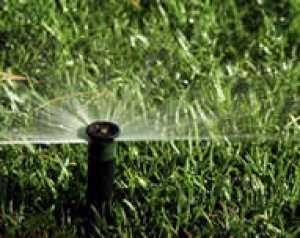Watering Q & A For the Summer Heat
August 14, 2013
Here are a few common questions I get about watering and watering systems:
 1. Sprinkler systems are expensive. Is it really worth the investment?
1. Sprinkler systems are expensive. Is it really worth the investment?
There are several reasons why a sprinkler system may or may not be right for you. If your landscape contains mostly woody plants and herbaceous ornamentals with little turf, you may want to stick with soaker-hoses/drip irrigation and hand watering. However, if you have an expansive lawn or you just don’t have the time to water, a sprinkler system may be the way to go. Turf requires deep watering in order to encourage a healthy root system. Hand watering or watering with mini-sprinklers usually doesn’t do the trick. A sprinkler system allows for proper and consistent watering with little effort. Because sprinkler systems are controlled automatically with timers, you can ensure your landscape won’t lay victim to drought while you’re on vacation in August! If you aren’t ready for an expensive underground sprinkler system, you may want to consider using an above ground stand-alone pulsating sprinkler, such as a Rain Tower. Stand-alone sprinklers are several feet tall and connect to standard garden hoses. In the long run, a good sprinkler system can increase the value of your home, which may make the investment a worthy one.
2. What kind of mulch is superior for moisture retention?
Most gardeners use organic mulches, which are derived from plant material, to conserve moisture in their landscape. Inorganic mulches include lava rocks, pebbles, plastic, or landscape fibers. Inorganic mulches can conserve moisture, but they do not break down to improve soil structure nor do they add nutrients. An important value of organic mulches is that they continuously add organic matter to the soil surface in addition to conserving moisture. Homemade organic mulches can be produced by recycling yard waste such as chopped or shredded leaves, wood chips, and dry grass clippings, or you can purchase mulches from your local garden center. Shredded hardwood mulch is an excellent choice if you are going to purchase mulch. Mulch should be applied as a 2-5 inch layer on top of your existing soil. Over-mulching will limit air and water movement to the soil and cause disease, so make sure not to over do it!
3. What is the trick to using soaker hoses?
Drip, trickle, or soaker hoses are ideal for use on woody plants, herbaceous ornamentals, and vegetable gardens. Soaker hoses use less water than conventional systems, such as the handy garden hose, operate at lower pressures than sprinkler systems, and save water by preventing run-off. Soaker hoses actually “sweat” water as opposed to spraying it into the air. The key to successfully using soaker hoses is to run them long enough. While you may be able saturate your soil to 6" deep by running a sprinkler system for 40 minutes; it could easily take 3 or 4 (or more) hours to get the same saturation with a soaker hose. Remember, it's a slow drip! One tip for using soaker hoses is to bury them underneath your mulch if you can. This not only holds the hoses in place, but also ensures that the moisture reaches the soil instead of getting trapped in the mulch. Soaker hoses are also very useful for keeping your foundation watered, which is crucial during our hot dry summers. Place the soaker hoses along the drip line of your home, or about 18 to 24” away from the foundation.
4. What time of day is best to water? As a general rule, how often and how deep should I water? As a general rule, how often and how deep should I water?
Early morning is the best time to water if you can. Watering during the evening or at night encourages fungal diseases on your turf and ornamentals. Watering during the middle of the day or afternoon can cause scorching. High soil temperatures also make it difficult for plants to take up water efficiently. When it comes to turf, the less often you water the better. Setting your sprinkler system for 10 or 15 minutes a day will do more harm than good. Shallow watering causes a shallow root system that is susceptible to disease and damage due to heat and cold. Water your turf about once a week for an hour early in the morning. In the heat of the summer you may need to increase to twice a week, but only if your grass is wilting (the blades will curl and it may have a bluish tint). Herbaceous ornamentals, such as your summer annuals, may need more frequent watering as summer progresses. Their root systems usually reach about 6 to12 inches deep, so check the surrounding soil every couple of days. Established trees and large shrubs only need supplemental watering during periods of drought, but newly planted trees should be watered frequently and deeply until they reach 2 to 3 years of age. Soaker or drip hoses are best used to keep your woody plants watered properly.
Be sure to abide by your city's water restriction guidelines!

